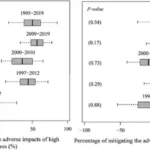
Living in proximity to cyanobacterial harmful algal blooms is not just a mere environmental concern; it has significant implications for human health, particularly among individuals diagnosed with amyotrophic lateral sclerosis (ALS), a progressive neurodegenerative disease. Recent compelling research conducted by Michigan Medicine sheds light on this correlation, unveiling findings that suggest people living near these blooms are at a heightened risk for deteriorating health outcomes, including an earlier mortality rate from ALS.
Cyanobacterial harmful algal blooms, often referred to simply as blue-green algae, arise under favorable environmental conditions such as nutrient-rich waters, warm temperatures, and ample sunlight, leading to explosive growth. This unchecked proliferation produces a barrage of toxic agents that pose risks not only to aquatic ecosystems but also to human health. Various studies have indicated that these cyanotoxins can cause serious illnesses ranging from gastrointestinal distress to neurological disorders. In particular, their potential link to neurodegenerative diseases has sparked intensified scrutiny in scientific communities.
With the increasing prevalence of these algal blooms across the United States, particularly in coastal and Great Lakes states, the study conducted by researchers from the University of Michigan highlights a critical public health issue that requires urgent attention. Participants in the study were identified from those receiving care at the University of Michigan Pranger ALS Clinic, where extensive health and residential histories were compiled. Utilizing satellite data from the Cyanobacteria Assessment Network, researchers meticulously quantified each participant’s exposure to harmful algal blooms.
.adsslot_lkA5XqF2WP{width:728px !important;height:90px !important;}
@media(max-width:1199px){ .adsslot_lkA5XqF2WP{width:468px !important;height:60px !important;}
}
@media(max-width:767px){ .adsslot_lkA5XqF2WP{width:320px !important;height:50px !important;}
}
ADVERTISEMENT
The survey results painted a concerning picture: a significant number of participants were found to reside within three miles of these toxic blooms. Importantly, the study revealed that engaging in recreational activities such as swimming and boating in contaminated waters could further elevate the risk of adverse health outcomes related to ALS. Findings indicate that individuals exposed to these blooms exhibited an accelerated mortality rate, with some succumbing to the disease nearly one year sooner than those with lesser or no exposure.
These alarming conclusions were encapsulated in a published study in the International Journal of Environmental Research and Public Health. Senior author Stephen Goutman, M.D., a key figure in the research and director of the Pranger ALS Clinic, expressed concern over the growing prevalence of harmful algal blooms and their potential to exacerbate health outcomes for ALS patients. Goutman emphasized the crucial link between long-term proximity to these toxic blooms and the adverse effects on survival rates, signaling a dire need for further research.
The implications of cyanobacterial toxins extend beyond mere water contamination; they infiltrate various aspects of daily life. Exposure can occur through several pathways, including ingestion, inhalation, and dermal contact during activities like swimming or fishing. The particular risks are heightened for individuals relying on private wells as their water source. The study identified that the subset of participants who had both significant exposures and used a private well were among those facing the most serious ramifications concerning their ALS prognosis.
Among the toxic agents produced by cyanobacteria lies β-methylamino-L-alanine (BMAA), a neurotoxin that has been implicated in various neurodegenerative diseases. This compound has been detected in the brain and cerebrospinal fluid of ALS patients, raising alarming questions regarding the pathways through which these toxins may contribute to the disease’s progression. Although the precise mechanisms are still under study, there is a growing body of evidence suggesting that exposure to these environmental toxins could play a role in the etiology of ALS.
While genetics undoubtedly influence the development of ALS, environmental factors significantly shape its trajectory. The phenomenon recognized as the ALS exposome reflects the cumulative impact of various toxic exposures throughout an individual’s life. In the United States, ALS incidence rates are particularly pronounced in the Midwest, an area heavily influenced by industrial agriculture and associated pollutants. The authors of the study suggest that the abundant inland lakes in the Midwest, known for prone blooming conditions for cyanobacteria, could partly explain the region’s elevated ALS rates.
As medical research continues to unravel the complexity of ALS, the necessity for an integrated epidemiological approach becomes evident. Such an approach must encompass the multitude of environmental exposures over an individual’s life course. Insights gained from studies like this one provide a roadmap to identify risk factors associated with the onset of ALS, along with their potential effects on survival. The research opens avenues for public health interventions and informs regulatory frameworks aimed at managing water quality and minimizing exposure to harmful algal blooms.
The urgency of tackling harmful algal blooms from both a scientific and societal perspective cannot be overstated. As climate change, agricultural runoff, and nutrient pollution contribute to the proliferation of these blooms, it is incumbent upon stakeholders, including policymakers and health officials, to devise strategies that protect vulnerable populations. Initiatives that address water treatment, public education about exposure risks, and monitoring of algal blooms are essential components in mitigating the public health crisis posed by cyanobacterial toxins.
To further underscore the importance of the findings, the research received prominent backing from multiple institutions, including the National Institutes of Health and the Centers for Disease Control and Prevention. The collaborative support underscores the significance of understanding environmental health dynamics connected to neurodegenerative diseases and highlights the potential for making informed public health decisions based on sound research data.
The landscape of ALS and its risk factors is complex, but the intersections with environmental exposures like harmful algal blooms present a growing concern that demands further investigation. As scientists continue to explore the hazardous implications of cyanobacterial toxins, the hope is that increased awareness will lead to preventive measures that can shield future generations from the tragic outcomes connected to diseases like ALS.
The battle against ALS is not solely a burden for those directly affected; it extends to families, communities, and health systems grappling with the deep, lasting repercussions of this debilitating disease. Understanding the environmental triggers and associations with neurodegenerative diseases may pave the way for transformative breakthroughs in treatment and prevention strategies. Consequently, as research continues to evolve, it is crucial to foster a dialogue that embraces both scientific inquiry and community engagement in tackling this multifaceted public health dilemma.
Subject of Research: The link between cyanobacterial harmful algal blooms and amyotrophic lateral sclerosis (ALS)
Article Title: Life Course Exposure to Cyanobacteria and Amyotrophic Lateral Sclerosis Survival
News Publication Date: Not specified
Web References: Links to the study and related organizations were provided in the content.
References: Michigan Medicine and the International Journal of Environmental Research and Public Health.
Image Credits: Not provided in the content.
Keywords
Amyotrophic lateral sclerosis
Neurodegenerative diseases
Environmental health
Cyanobacteria
Harmful algal blooms
Public health
Water quality
Toxins and pollutants
Tags: algal blooms and mortality ratesALS and environmental factorsblue-green algae health riskscoastal states algal bloom prevalencecyanobacterial toxicity effectsenvironmental health and neurodegenerationharmful algal blooms and human healthlife expectancy in ALS patientsMichigan Medicine ALS researchneurodegenerative diseases and algal exposurepublic health concerns related to cyanotoxinstoxic agents from cyanobacteria



